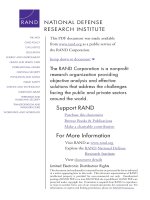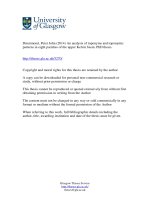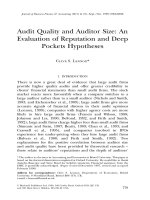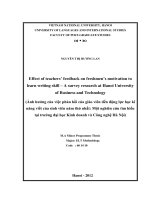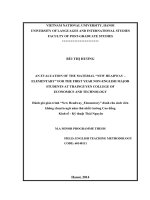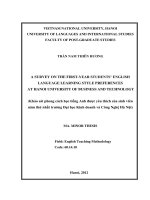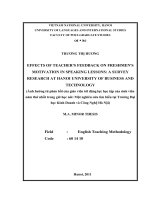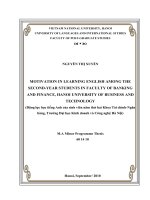An evaluation of the appropriateness of material elementary market leader for hanoi university of business and technology
Bạn đang xem bản rút gọn của tài liệu. Xem và tải ngay bản đầy đủ của tài liệu tại đây (1.63 MB, 50 trang )
Vietnam National University
College of Foreign Languages
POSTGRADUATE DEPARTMENT
NGUYEN THI THU HIEN
AN EVALUATION OF THE APPROPRIATENESS OF
MATERIAL “ELEMENTARY MARKET-LEADER” FOR HANOI
UNIVERSITY OF BUSINESS AND TECHNOLOGY
(ĐÁNH GIÁ ĐỘ PHÙ HỢP CỦA GIÁO TRÌNH “ELEMENTARY MARKET-LEADER” ĐỐI VỚI
TRƯỜNG ĐẠI HỌC KINH DOANH VÀ CÔNG NGHỆ HÀ NỘI)
M.A Minor Program Thesis
Field: Methodology
Code: 601410
HANOI – JULY, 2009
Vietnam National University
College of Foreign Languages
POSTGRADUATE DEPARTMENT
NGUYEN THI THU HIEN
AN EVALUATION OF THE APPROPRIATENESS OF
MATERIAL “ELEMENTARY MARKET-LEADER” FOR HANOI
UNIVERSITY OF BUSINESS AND TECHNOLOGY
(ĐÁNH GIÁ ĐỘ PHÙ HỢP CỦA GIÁO TRÌNH “ELEMENTARY MARKET-LEADER” ĐỐI VỚI
TRƯỜNG ĐẠI HỌC KINH DOANH VÀ CÔNG NGHỆ HÀ NỘI)
M.A Minor Program Thesis
Field: Methodology
Code: 601410
Supervisor: Dr. DUONG THI NU
HANOI – JULY, 2009
iv
TABLE OF CONTENTS
CANDIDATE’S STATEMENT
1
ACKNOWLEDGEMENTS
ii
ABSTRACT
TABLE OF CONTENTS
LIST OF ABBREVIATIONS
LIST OF FIGURES AND TABLES
iii
iv
vi
vii
INTRODUCTION
1
1. BACKGROUND TO THE STUDY AND STATEMENT OF THE PROBLEM
2. AIMS OF THE THESIS
3. SIGNIFICANCE OF THE THESIS
4. THE RESEARCH QUESTIONS
5. THE SCOPE OF THE STUDY
6. OVERVIEW OF THE THESIS
1
2
2
2
3
3
DEVELOPMENT
5
CHAPTER ONE: LITERATURE REVIEW
1.1. MATERIALS IN LANGUAGE TEACHING AND LEARNING
1.1.1 The Roles of Teaching Materials
1.1.2. Types of Materials
1.1.2.1. Textbooks
1.1.2.2. In-house Materials
1.2. MATERIALS EVALUATION
1.2.1. Reasons for Materials Evaluation
1.2.2. Definitions of Materials Evaluation
1.2.3. Types of Materials Evaluation
1.2.4. Models for Materials Evaluation
1.2.5. Criteria for Materials Evaluation
1.3. MATERIALS ADAPTATION
1.3.1. The Context of Adaptation
1.3.2. Reasons for Adaptation
1.3.3 Techniques for Adaptation
CHAPTER TWO: METHODOLOGY
2.1. THE SETTING OF THE STUDY
2.2. THE MATERIAL ELEMENTARY MARKET-LEADER USED FOR FRESHMEN AT HUBT
2.3. DATA COLLECTION METHODS
2.4. DATA COLLECTION PROCEDURE
2.4.1. Document Analysis
2.4.2. Student Questionnaire
2.4.3. The Teacher Interviews
2.5. SUBJECTS OF THE RESEARCH
2.5.1. The students
5
5
5
7
7
8
8
8
9
10
10
12
14
14
15
15
18
18
18
19
19
19
20
20
21
21
v
2.5.2. The teachers
21
CHAPTER THREE: DATA ANALYSIS AND DISCUSSION
23
3.1. THE APPROPRIATENESS OF THE MATERIAL TO THE STUDENTS’ LEVEL OF ENGLISH.
23
3.1.1 Document Analysis
23
3.1.2. Results from the Survey
23
3.1.2.1. Teacher Interviews
23
3.1.2.2. Student Questionnaire
26
3.1.3. Discussion
28
3.2. THE APPROPRIATENESS OF THE MATERIAL TO THE METHODOLOGY
REQUIREMENTS OF THE COURSE
30
3.2.1. Teaching and Learning Techniques
31
3.2.1.1. Document Analysis
31
3.2.1.2. Student Questionnaire
31
3.2.2. The Guidance and Support from the Material for Teachers
32
3.2.2.1. Document Analysis
32
3.2.2.2. Teacher Interviews
33
3.3. MAJOR FINDINGS
35
3.3.1. The Appropriateness of the Material to the Students’ Level of English.
36
3.3.2. The Appropriateness of the Material to the Methodology Requirements of the Course
36
CONCLUSION
1. ADAPTATIONS
1.1. The Difficulty of the Material
1.2. The Guidance and Support from the Material for Teachers
2. CONCLUSION
3. THE LIMITATIONS OF THE THESIS
REFERENCES
APPENDIX 1
APPENDIX 2
38
38
38
39
40
40
1
I
V
vi
LIST OF ABBREVIATIONS
EFL
English as a Foreign Language
ESP
English for Specific Purposes
ELT
English Language Teaching
HUBT
Hanoi University of Business and Technology
vii
LIST OF FIGURES AND TABLES
Figure 1
Stages in the ESP Process (Dudley-Evans and St. John, 1998: 121)
Figure 2
Materials Evaluation Process (Hutchinson & Waters, 1987)
Table 4.1
Teachers’ Opinions of the Appropriateness of the Material to the
9
11
Students’ Level of English
23
Table 4.2
Teachers’ Opinions on the Difficulty of Different Parts of the Material
23
Table 4.3
Students’ Assessment of the Difficult Sections in the Material
25
Table 4.4
Students’ Opinions on the Reasons Why Some Sections are Difficult
26
Table 4.5
Teaching and Learning Techniques Used and Suited to the Students
30
Table 4.6
Teachers’ Evaluation of the Guidance and Support from the Material
33
5
DEVELOPMENT
CHAPTER ONE: LITERATURE REVIEW
This chapter is aimed at providing a theoretical base to develop an operational
framework for the evaluation of the material “Elementary Market-Leader” currently used
for first-year students of business majors at Hanoi University of Business and Technology
(HUBT).
The first part in this chapter relates to teaching materials with regards to their roles
in language teaching and types of materials. The second part presents the review of
literature concerning major issues in materials evaluation, model for evaluation and criteria
for evaluation. The third part discusses some important issues about materials adaptation.
1.1. MATERIALS IN LANGUAGE TEACHING AND LEARNING
1.1.1 The Roles of Teaching Materials
Teaching materials are a key component in most language programs. According to
Dudley Evans & St. John (1998), materials are used in all teaching and their role in the
process of language teaching and learning is of great importance.
Nunan (1988) also mentions the vital role of teaching materials as follows:
“Materials are in fact an essential element within the curriculum, and do more than simply
lubricate the wheels of learning. At their best they provide concrete models of desirable
classroom practice, they act as curriculum models for teachers to follow in developing their
own materials.” (p.98)
The roles of teaching materials in language teaching in general and in ESP in
particular will be discussed in more details in the next part of this section.
The Role of Teaching Materials in General English Course.
The important roles that teaching materials play in language teaching are
mentioned by different authors in the literature. Richards and Rodgers (cited in Nunan,
1991) view instructional materials as detailed specifications of content, and guide to
teachers on both the intensity of coverage and the amount of attention demanded by
6
particular content or pedagogical tasks.
Richard and Rodgers’s perspective is supported and clarified by Richards (2001),
who pointed out that teaching materials can serve as the basis for much of the language
input that the learners received and as the source for much of the language practice that
occurs in the classroom. Richard further explains that materials provide a basic for the
content of the lesson, the balance of skills taught, and the kind of language practice
students take part in.
The Role of Teaching Materials in ESP Course
Dudley-Evans and St John (1998) have summed up four functions of teaching
materials in ESP course: as a source of language, as a learning support, as a source of
motivation and stimulation and as a source for reference.
As a source of language:
In some situations where English is a foreign language, not a second language, the
ESP classroom may be almost the only source of English. Materials the play a crucial role
in exposing learners to the language, which implies that the materials need to present real
language, as it is used, and the full range that learners require. Therefore, materials need to
maximize exposure to the language, for instance, by providing additional materials.
As a learning support:
As a learning support, materials need to be reliable, that is, to work, to be consistent
and have some recognizable pattern. To enhance learning, materials must involve learners
in thinking about and using the language. The activities need to stimulate cognitive, not
mechanical processes. The learners also need a sense of progression.
As a source for stimulation and motivation:
In order to stimulate and motivate students, materials need to be “challenging yet
achievable; to offer new ideas and information whilst being grounded in the learners’
experience and knowledge” (Dudley-Evans & St John, 1998: 172). They further explain
that the input must contain concepts and/ or knowledge that are familiar to the learners, but
it must also offer something new, a reason for the learners to communicate and to get
involved.
7
As a source for reference:
Materials help learners to make “efficient use of the resources in order to facilitate
self-discovery” (Tomlinson, 1998: 11). For this function, according to Dudley-Evans & St
John (1998), the materials need to be “complete, well laid out and self-explanatory”
(p172). In other words, the materials need to provide explanations, examples and practice
activities that have answer and discussion key so that the students can use them for selfstudy. What needs to be taken into account at this point is the difference in learning styles
among the learners. This means that activities should be “variable and should cater for all
learning styles” (Tomlinson, 1998: 17).
Obviously, teaching materials are a key and crucial component in any language
teaching contexts. The teacher needs to take account of the roles as well as the
requirements of teaching materials when designing and selecting materials for his or her
own teaching situation to facilitate the most learning form students.
1.1.2. Types of Materials
1.1.2.1. Textbooks
Textbooks refer to the commercially published materials. The most obvious
advantage of these materials is its availability for use. O’Neil (cited in Robinson, 1991)
believes that no other medium is as easy to use as textbook. More importantly, “a textbook
is complete not just in the physical sense but in the sense that the whole term’s or year’s
course is available to the students at once” (p58).
In some situations, textbooks serve as the basis for much of the language input
learners receive and the language practice that occurs in the classroom. They provide
structures and syllabus for a program that has been systematically developed and planned.
However, textbooks also have some limitations. Ewer and Boys (cited in Robinson, 1991)
present a strong attack on published textbooks that some really fundamental factors of
textbooks such as the validity of the linguistic content, the accuracy of the explanations
and examples given, the number and coverage of the exercises provided have been ignored
because the writers just focus on approach and methodology. Moreover, as Swales (cited in
Robinson, 1991) indicates published textbooks are “less-sufficient in practice materials and
in coverage of skill areas” (p57) so the textbooks need to be supplemented by other
8
materials.
1.1.2.2. In-house Materials
There are also arguments for and against the use of in-house materials. According
to Robinson (1991), there are three advantages of in-house materials. Firstly, in-house
materials are likely to be more specific and appropriate than public textbooks and to have
greater face validity in terms of the language dealt with and the context it is presented in.
Secondly, in-house materials may be more flexible than published textbooks. Finally, the
writer of in-house materials can make sure that methodology is suitable for the intended
learners. Despite advantages of in-house materials, there are some disadvantages.
Robinson (1991) indicates that making in-house materials is time-consuming and
expensive, what is worst is that many locally produced materials “show a striking
resemblance to the published materials that have been rejected” (Swales, cited in
Robinson, 1991: 58).
1.2. MATERIALS EVALUATION
1.2.1. Reasons for Materials Evaluation
Materials evaluation cannot be apart from a language training program. There are
many reasons that language course organizers and teachers worldwide are connected with
when they conduct materials evaluation.
On discussing the problem, Ellis (1997) points out that the need for materials
evaluation retrospectively takes on special importance. Such an evaluation provides
teachers with information which can be used to determined whether it is worthwhile using
the materials again, which activities “work” and which do not, and how to modify the
materials to make them more effective for future use”.
In ESP, according to Dudley-Evans and St. John (1998), materials evaluation is an
indispensable part of the key stages in ESP process (See Figure 1).
Need analysis
Evaluation
Assessment
Course design
Teaching-learning
9
Figure 1: Stages in the ESP Process (Dudley-Evans and St. John, 1998: 121)
In this figure, it is clear that need analysis is “the process of establishing the
effectiveness” (Dudley-Evans and St. John, 1998:121). In other words, after being used in
the classroom, teaching materials need to be evaluated to see if they have worked well for
the intended situation and audience.
Materials should be evaluated to identify particular strengths and weaknesses; it
will help to determine whether the materials are effective and efficient. On that basis,
decisions can be made on whether to use the materials or not and what should be changed
so that the materials can be well suited for the course.
1.2.2. Definitions of Materials Evaluation
There is a wide range of different definitions of materials evaluation from different
researchers. This section is a review of the definitions from outstanding researchers in
order to bring an overview of materials evaluation.
Brown (1987) states
“Evaluation is the systematic collection and analysis of all relevant information necessary to
promote the improvement of curriculum and assess its effectiveness within the context of
particular situation involved” (p.223)
Dudley-Evans & St. John believe that evaluation is a complete process “which
begins with determining what information to gather and ends with bringing about change
in current activities or influencing future ones” (p.128)
Of the most prominent definitions of evaluation is the one by Hutchinson & Waters
(1987):
“Evaluation is a matter of judging the fitness of something for a particular purpose. Given a
certain need and in the light of resources available, which out of a number of possibilities can
represent the best solution? Evaluation is, then, concerned with relative merit. There is no
absolute good or bad, only degree of fitness for the required purpose” (Hutchinson & Waters,
1987)
From the general definitions of evaluation and the definition of a specific area of
materials evaluation, it can be inferred that materials evaluation involves the determination
of what need to be evaluated, the objectives and requirements of the materials, the
judgment of the value of materials being evaluated in relation to the objectives and
requirements determined.
10
1.2.3. Types of Materials Evaluation
Robinson (1991) suggests three types of materials evaluation: preliminary,
summative, and formative. It is noted that the first two types are likely to focus on
published or at least completed materials, and the third on in-house materials. Preliminary
evaluation takes place before the course begins and involves selecting the most appropriate
from the publications that are available. Formative evaluation is conducted while the
course is ongoing, so that modifications can be made to the materials. Meanwhile,
summative evaluation takes place at the end of a course and raises the question of whether
the materials have been effective.
Ellis (1997) introduces two new terms related to types of materials evaluation:
predictive and retrospective. Predictive evaluation is designed to make a decision
regarding what materials to use while retrospective evaluation examines the materials that
have actually been used.
Recently, Tomlinson (1998, p3) has referred to three notions pre-use, while-use
and post-use when classifying types of materials evaluation. Pre-use evaluation predicts
whether materials will work, and whether the learners will be able to use them without too
much difficulty and will enjoy the experience of doing so. While-use evaluation examines
how materials really work in the classroom. Moreover, post-use evaluation aims to find out
how actually effective they are.
Although the different terms are used to indicate the types of materials evaluation,
they are basically similar. First, preliminary, predictive and pre-use evaluations involve a
process to search for good materials. Next, formative and while-use evaluations describe
how materials are being exploited. Certainly, summative, retrospective, and post-use
evaluations are all used to determine how effectively materials have been used.
As Weir & Robert (1994) suggest, it was agreed that, owing to the aims of
evaluation, a formative style or on-going evaluation using qualitative data would be
suitable for evaluating the materials. Thus, in this study, the researcher uses formative
evaluation as the main type of materials evaluation.
1.2.4. Models for Materials Evaluation
There are a number of different ideas on designing a reliable framework of
materials evaluation. The popular frameworks are the one suggested by Hutchinson &
11
Waters (1987), Littlejohn (1998), Mc Donough and Shaw (1993), Cunningsworth (1984)
and Ellis (1997). However, in this thesis, I would like to focus only on Hutchinson &
Waters’ model as I intend to use it for my evaluation.
Hutchinson & Waters (1993) define materials evaluation as a “matter of judging the
fitness of something for a particular purpose” (p.96). In this view, the evaluation is divided
into four major steps (see Figure 2):
o Defining criteria
o Subjective analysis (i.e. the analysis of the course in terms of materials requirements)
o Objective analysis (i.e. the analysis of materials being evaluated)
o Matching
What must be done in each stage is presented in the following diagram:
DEFINE CRITERIA
On what bases will you judge materials?
Which criteria will be more important?
SUBJECTIVE ANALYSIS
OBJECTIVE ANALYSIS
What realizations of the criteria do
How does the material being
you want in your course?
evaluated realize the criteria?
MATCHING
How far does the material match your
need?
Figure 2:
Materials Evaluation Process (Hutchinson & Waters, 1987)
This model presents a logical procedure for materials evaluation. To examine
whether the materials are suitable for a certain group of learners or not there must be
certain criteria against which our judgment or evaluation are based. It is also necessary to
determine the objectives or the requirements for the materials because we cannot measure
12
the success of a particular activity or a whole set of materials if there is no clear objective
for it.
According to the diagram above, it is very important to set out the criteria for both
objective and subjective analysis. Hutchinson & Waters (1987) shows for basic criteria
with a number of specific points for evaluators to consider: intended audience, aims,
content, and methodology.
The first point, intended audience, is the analysis of the learners’ personal
identification, such as the learner’s age, sex, interests, specialism, knowledge of English/
specialism and their educational backgrounds.
The next basic criterion deals with the aims of the course and the materials.
The third criterion, content, is the most important point since it helps evaluators to
have an overview of both course requirements for materials content and the content
treatment of those materials. When analyzing the content subjectively and objectively,
researchers should focus on a number of such sub-criteria as language description,
language points, macro-skills and their proportion, micro-skills, text types, subject matter
areas, topics, content organization, and sequence.
Methodology, the next criterion for both subjective and objective analysis concerns
the theories of learning, the learners’ attitudes to learning English, types of tasks/ exercises,
teaching-learning techniques, learning facilities, guidance/ support for teaching, and the
flexibility of the materials.
1.2.5. Criteria for Materials Evaluation
Criteria are what evaluators use to “reach a decision regarding what needs to be
evaluated” (Tomlinson, 1998: 220). In other words, they are the bases upon which the
evaluators depend when making judgments. Defining criteria for evaluation is one of the
crucial issues evaluators must take into account before any evaluation can take place.
The following is the criteria suggested by Hutchinson and Waters’ checklist for
materials evaluation.
Audience
According to Hutchinson and Waters (1993), in the learning-centered approach to
ESP, the overall aim of the ESP course is to meet the needs of a particular group of
13
learners. ESP materials must therefore be designed or selected according to the needs of
the specific learners. So the first criteria in materials evaluation is the audience of the
materials with regard to different kinds of information such as age; sex; study or
professional fields; status with respect to professional fields; knowledge of English, of area
of work or study and of the world; educational background; interest and so on.
Aims
In any language course, a materials evaluation need to be carried out to find out if
the materials can satisfy the aims and objectives of the course.
Content
According to Hutchinson and Waters, it is really necessary to measure if the
content of the materials is suitable to the content requirements of the course in terms of
language description, language points, proportion of work, micro-skills, text-types, macroskills and proportion. In ESP, it is very important to take into consideration the learners’
subject-matters in terms of level of knowledge, types of topics, and how these topics are
presented. Finally, these evaluations need to find out if the way the content is organized
and sequenced within a unit and throughout the course is appropriate.
Methodology
Many aspects in terms of materials methodology need to be evaluated. First of all,
the evaluation needs to indicate whether the theories of learning on which the course is
based are in line with the one of material under evaluation. Secondly, evaluators need to
measure whether the learners’ expectations about learning are the ones the materials are
intended for. Thirdly, it is necessary to determine whether the kinds of exercises/ tasks
included in the materials are suited to the course requirements. Another aspect to be
evaluated is the teaching and learning techniques: whether the teaching-learning techniques
that can be used with the materials are those required by the course and suitable to the
learners. Furthermore, the evaluation needs to find out whether the materials supply the
teachers with necessary guidance and support for teaching the course. Finally, it is
necessary to determine if the materials are flexible so that they can be used in a different
order to suit the teaching contexts.
Within a small-scale study, the evaluator would like to concentrate on evaluating
14
the appropriateness of the material to the students’ level of English and to the requirements
of methodology of the course. In other words, the researcher examines the suitability of the
material “Elementary Market-Leader” with first-years students of HUBT on the following
points:
o Appropriateness of the material to the students’ level of English:
-
The difficulty of the material.
o Appropriateness of the material to the methodology requirements of the course:
-
The suitability of the teaching and learning techniques of the material to the
students.
-
The guidance and support from the material for teachers.
1.3. MATERIALS ADAPTATION
According to Richard et al (1992, p.5), “adaptation is a process of making changes
to published texts or materials to make them more suitable or appropriate for a particular
teaching needs”. Certainly, there is no perfect textbook, which can be relevant to all
teaching and learning context, thus, adaptation is a very necessary process to maximize the
appropriacy of teaching materials in particular context by changing some of the internal
characteristics of a textbook or set of materials to better suit our situation.
1.3.1. The Context of Adaptation
Mac Donough and Shaw argue that with a wider perspective in mind, and as a
starting point for thinking about the process of adaptation, it will be useful to extend little
the criteria put forward to the heading of “external” and “internal”.
External (what we have)
Internal (what the materials offer)
Learner characteristics
Choice of topics
Physical environment
Skills covered
Resources
Proficiency level
Class size
Grading of exercises
External factors comprise both the over claims made about materials and more
significantly for the present chapter, the characteristics of particular teaching situations.
Internal factors are concerned with content, organization and consistency. To adapt
materials is to try to bring together these individual elements under each heading, or
15
combination of them, so that they match each other as closely as possible.
Adaptation is an essential process of matching. Its purpose is to maximize the
appropriateness for leading materials in context by changing some of the internal
characteristics of a course book to better suit our particular circumstance. We will now
look in more details at possible reasons for adaptation, and some of the procedures
commonly used.
1.3.2. Reasons for Adaptation
According to Mc Donough and Shaw (1993), the followings are the possible areas,
which are often taken into account in adaptation:
1. There is not enough grammar coverage in general.
2. There is not enough practice of grammar points of particular difficulty to these
learners.
3. Reading passages contain too much unknown vocabulary.
4. Comprehension questions are too easy because the answers can be lifted directly from
the text with no real understanding of the text.
5. Subject matters are inappropriate for learners of this age and intellectual level.
6. Photographs and other illustrative materials are not culturally acceptable.
7. Amount of material is too much/ too little to cover in the time allocated to lessons.
8. There is no guidance for teachers on handling group work and role play activities with
a large class.
9. There is too much or too little variety in the activities
10. There is no vocabulary list or a key to exercises provided.
The reasons for adaptation presented above can be grouped into (a) aspects of
language use, (b) skills, (c) classroom organization, and (d) supplementary materials. Mc
Donough and Shaw states that more adaptation areas can be added to this list; however, the
areas should be identified according to certain contexts.
1.3.3 Techniques for Adaptation
Wallace (1998, p.190) introduced two following ways to adapt materials:
“1. Retain the materials basically as they are, but teach them in a different way (i.e. either
different from the way you normally teach them, or from the way recommended in the
Teacher’s book.
16
2. Change the materials in some ways, for example by devising new materials either instead of
or in addition to some parts of the existing materials.”
Mc Donough and Shaw (1993) suggest five main techniques for adaptation:
modifying, simplifying, adding, deleting, and reordering.
Modifying
This technique can be applied to any aspect of content. It is subdivided into two
specific ways: re-writing and re-structuring. Re-writing refers to the modification of the
linguistic content. For example, if easy end-of-text comprehension questions just require
the students to use information directly from the text to answer, they can be modified so
that students have to interpret what they have read or relate different section of the text
together. Re-structuring, unlike re-writing, applies to classroom management, specifically,
to the structuring of the class. For example, there are some role-play activities for groups
of certain size in the materials. If students are in a large class, it is necessary to assign one
role to a number of students at the same time.
Simplifying
Simplification is basically a re-writing activity of modification. Many elements of a
material can be simplified. However, this technique has mainly applied to texts (reading
passages). The texts with their sentence structures, grammatical structures and lexical
contents are often simplified in order to be closer to the proficiency level of a particular
group of learners.
Adding
The notion of addition can imply that the materials are supplemented by putting
more into them and taking into account the practical effect of it on time allocation as well.
Addition can be done by the techniques of extending and expanding. Extending
means an addition “within the methodological framework of the original materials” (Mc
Donough and Shaw, 1993: 89) while expanding is conducted by putting in a different
language skill or a new component. Addition can be made before, during or after the
intended area.
Deleting or Omitting
Addition and deletion work together in the sense that part of a text or an exercise
17
may be taken out and then replaced with something else of the same type. Moreover, as
task may be deleted and compensated by a more suitable one to meet the objectives of the
whole unit. So it is necessary to take into consideration the balance of the lesson as well as
the time allocation when these techniques of adaption are applied.
Re-ordering
This technique refers to the possibility of arranging the parts of a course book in a
different order. This can be the adjustment of the sequence within a unit, or even the
arrangement of different units in a course book.
In general, adaptation is a practical activity carried out by teachers in order to make
the teaching materials more relevant and appropriate for a particular group of learners. The
responsibility of the teacher is to decide which features of the material need to be changed,
and choose the most suitable techniques to adapt the material in use.
To sum up, this chapter has discussed the theoretical issues concerning materials
evaluation and adaptation. It provides the ground for the following chapters of the thesis.
18
CHAPTER TWO: METHODOLOGY
This chapter provides a description of the setting of the study, the subjects
participating in the study, the instruments for collecting data including questionnaires and
interviews, and the procedure of data collection.
2.1. THE SETTING OF THE STUDY
The study was conducted at Hanoi University of Business and Technology
(HUBT). One questionnaire was distributed to 120 first-year students and collected at the
University during the survey. The process or semi-structure interview was also carried out
at the same time among10 teachers of HUBT.
Since the study was conducted at HUBT, it is necessary for the researcher to
outline the current situation of teaching and learning the material “Elementary MarketLeader” at the university as the setting for the study.
The subjects of the study are first-year students at HUBT who have passed the
entrance exam into the university, which was administered in accordance with the
principles set by the Ministry of Education. The students, however, have very different
backgrounds. Most of them come from the country while some others are from the cities.
Some have learnt English for 7 years, while some others have had three years with English.
Also, a number of them had quite focused on English for they chose to take the university
entrance exam with an English test whereas the rest took the exam without an English test.
As a result, when they are grouped into the same class, they vary in not only English
proficiency but also their learning styles.
2.2.
THE
MATERIAL
“ELEMENTARY
MARKET-LEADER”
USED
FOR
FRESHMEN AT HUBT
“Elementary Market-Leader” is the first in the three-level set of course books of
business English “Market-Leader” by three authors from London Metropolitan University David Cotton, David Falvey and Simon Kent. It consists of 12 units based on the topics
involved in international business. The main course book is supported by some other
components like Practice File, Test File, and Teacher’s Resource Book, Audio Materials,
19
and the website www.market-leader.net.
“Elementary Market-Leader” is used for first-year students of business majors at
HUBT. The twelve units in the book cover the whole academic year comprising of two 18week semesters, so in each semester, the students study 6 units. In class, teachers and
students not only deal with students’ books but also other components of the set like
Practice File (listening and pronunciation practice) and Text Bank (reading materials). In
each unit of the material, the language contents include starting up, vocabulary, listening,
language focus, reading, skills, and case study. The topics of the units are business-related
topics ranging from basic topics like introduction, work and leisure, travel,… to more
business-focused topics like sales, markets, companies, the Web,…
2.3. DATA COLLECTION METHODS
This section focuses on the instruments used for data collection including a
discussion of strength and weaknesses of the method chosen.
According to Robinson (1991), many of basic procedures for data collection are the
same as those that can be used for need analysis and evaluation process: checklist,
questionnaire, discussion, rating scales, interview, observation, record, and assessment.
On discussing the methods for materials evaluation, Robinson (1991) states that
tests, questionnaires, and interviews are the main techniques used for formative evaluation.
Meanwhile, summative evaluation makes use of tests administered before and after
program in addition to checklists and questionnaires.
In this study, questionnaires, interview, and document analysis have been chosen
as the main methods to collect data for the evaluation. Questionnaires were designed to
collect the data that relate to the students’ attitudes and opinions towards the materials that
they are studying. Besides, interviews were conducted to seek the collaboration of teachers
in evaluating the material and to get their attitudes towards the material that they have been
using.
2.4. DATA COLLECTION PROCEDURE
2.4.1. Document Analysis
For materials evaluation, document analysis is an important channel to collect data
20
for the thesis. Although there are many documents that can be used for evaluation such as
textbooks, tests, audio and video materials, and recording of classroom activities, within
the framework of this thesis, the writer pays much attention to the analysis of the course
book “Elementary Market-Leader” in terms of its relevance to the students’ level of
English and the suitability of the material to the methodology requirements in terms of
teaching-learning techniques, and guidance and support from the material for teachers.
2.4.2. Student Questionnaire
Beside the data collected by analyzing the material under study, the researcher
made use of a questionnaire to investigate the students’ opinions and attitudes towards the
material concerning their opinions on the level of difficulty and the relevance of the
methodology of the course book. The purpose of getting these data was to get more
information about the material.
A questionnaire was randomly delivered to 120 students, and 107 copies were
returned. 100 out of 107 were then randomly chosen for data analysis.
The student questionnaire consists of two sections with 9 questions. Section I
includes 7 questions designed to find out the students’ perspectives on the difficulty level
of the material and the reasons why they think some certain sections of the material are
difficult. Section II has 2 questions which aim at the students’ opinions on the
methodology of the material. The students are asked to inform about the teaching and
learning techniques that their teachers use in class and how they like them. Their answers
are expected to provide information of how the material methodology matches their
learning styles. (See Appendix 1)
The questionnaire is translated into Vietnamese as the informants of the study are
all first-year students and also to avoid any misunderstanding on the questions.
2.4.3. The Teacher Interviews
In addition to the material analysis carried out by the researcher and the
questionnaire completed by the students, another data collection instrument that was used
was interview with teachers who had been using this material for years. The teacher
participants were given the questions in advance so that they could prepare for the
interviews. During the interview, besides the prepared questions they were also asked some
21
follow-up questions to identify their viewpoints more clearly. The researcher decided to
use Vietnamese as the language of communication in the interview so that the teachers
could feel comfortable at best to express their thoughts and opinions on the material.
During the interviews, the researcher took notes of answers. The interviews were
also recorded to support the researcher in analyzing the information at the best possible
level.
The interview questions were divided into 2 sections with 10 questions. Section I,
comprising 5 questions, deals with the teachers’ viewpoints on the appropriateness of the
material to the student’s level of English and on the difficulty level of the material. Section
II, which has another five questions, focuses on investigating the teachers’ evaluation of
the guidance and support that the material provides them for teaching the course.
2.5. SUBJECTS OF THE RESEARCH
2.5.1. The students
The informants of the study are first-year students majored in business. They come
from four different majors of HUBT: Business Administration, Finance & Banking, Trade,
and Economics . They are from different parts of Vietnam: cities, towns, and rural areas.
They are all between 17 and18 years of age. At the time of the survey, all of them are in
the middle of the second semester with HUBT. More specifically, the students have
already finished 9 out of 12 units in “Elementary Market-Leader”.
2.5.2. The teachers
The research informants include 10 teachers who have been teaching English,
especially Business English, at HUBT for many years comprising at least 2 years’ time
dealing with the material Elementary Market-Leader. Five of them have obtained Master
Degree in TEFL while the rest have just acquired Bachelor Degree. As regards their
experience in teaching Business English, six of them have involved in teaching other
Business English materials like International Express, Business Objectives before using
“Elementary Market-Leader”. However, most of them admit they have limited knowledge
and experience in teaching Business English, which may prevent them from teaching
effectively. Another problem is that most of the teacher-student communication in class is
22
in Vietnamese, which does not encourage students to use English during the lesson.
In summary, this chapter has identified the setting, instruments, and procedure of
the study. The next chapter will present the figures and data collected in the student survey
and teacher interviews, from which some initial conclusions about the questioned issues of
the study start to take shape.
23
CHAPTER THREE: DATA ANALYSIS AND DISCUSSION
This chapter is a detailed analysis of the material, a presentation and discussion of
the results from the survey with the students and the interviews with the teachers. The data
is analyzed to find out the appropriateness of the material to the students’ level of English
and to the methodology requirements.
3.1. THE APPROPRIATENESS OF THE MATERIAL TO THE STUDENTS’
LEVEL OF ENGLISH.
3.1.1 Document Analysis
In order to determine whether the material is suitable to the student’s level of
English or not, a comparison is made between the English level of the students and that of
the audience for whom this material is intended.
According to the Introduction in the course book, Market-Leader is an elementary
level business English course which is intended for both business people and students of
business. The Course book’s Introduction says that the course is for finished beginners and
elementary students of English.
In comparison with the level of the targeted students at HUBT who attend the
course, the intended level is, generally, quite agreeable. Most of the first-year students of
business majors (which are business administration, finance & banking, trade, and
economics), on entering the course, have had at least three years with English at school.
They are, therefore, supposed to have past the beginner level. However, as mentioned in
the previous chapter, there is a mixture of student levels. Also, most of them have very
little chance to practice speaking and listening in English, which reflects the traditional
way of teaching English in most schools in Vietnam. Furthermore, before starting this
course, hardly any of them had access to Business English as well as the knowledge of
Business as a subject of their major. Thus, it is sometimes quite hard for them to catch the
purpose of some certain activities offered in the course book and carried out in class.
3.1.2. Results from the Survey
3.1.2.1. Teacher Interviews

